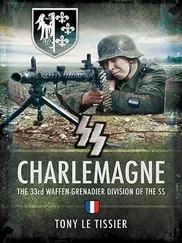I drove out from Frankfurt an der Oder with eight to ten armoured personnel carriers (APCs). The enemy situation was unknown. All that was known was that the Replacement Brigade ‘Grossdeutschland’ was trapped in the Reppiner Forest northeast of Kunersdorf and was making desperate attempts to break out. We had to try and force a passage through to the west.
As we got close, I saw that fighting was taking place in Kunersdorf. We reached the edge of the village, where we stopped and I went forward to reconnoitre. I worked my way forward as far as the centre of the village, which was still held by our infantry, the eastern part being occupied by the Russians. T-34s and anti-tank guns were firing down the main street and Russian infantry were occupying the houses and gardens. An attack on our part could not have been successful and would only have led to severe casualties. I had my men dismount under covering fire from the APCs. The Russians were then unable to make any further headway.
While running across the street I ran straight into a burst of fire from the Russians and was scorched by a tracer bullet on my leg. We tried to drive the Russians out of the eastern part of Kunersdorf with shock troops but, after gaining thirty to fifty metres, we had to give up. The enemy forces were too strong and were far from idle: we had to keep on our toes throughout the night to avoid being surprised.
A new day began. Our comrades were still unable to break out of their encirclement. Our forces were too weak to break through the Russian ring. Then, towards midday, I was ordered to hand over my positions to some SS-grenadiers and to take the village of Trettin, about four kilometres north of Kunersdorf. The relief came, hand-over and briefing were soon completed and I got my men to mount up and drive off.
We drove continuously through the potentially dangerous terrain with all necessary care, having to reckon with enemy intervention at any moment, crawling unseen through the dips and hollows to Trettin. We reached to within a thousand metres of the village, from which we were concealed by a low hill. Trettin was already occupied by the enemy. We could see several enemy tanks. Although they were partly covered positions, we could still make them out. We did not know how strong the enemy was. What were we to do?
To attack across the open ground to the edge of the village in our lightly armoured vehicles would be suicidal, and to go round by a flank impossible. We had no artillery at our disposal and there were certainly still some civilians in the village. How could we take Trettin under these circumstances? It was a damnable situation, but a soldier has to have luck.
Suddenly we heard aircraft approaching. ‘Stukas!’ I shouted, ‘Get out the identification panels!’ We did not want to be attacked by our own aircraft.
They flew at medium height over us and banked round over Trettin. The village was flown over once more and then, with the next flight, we witnessed a unique display with deadly results for the enemy. From medium height the first machine flipped over on its wings and dived down with an ear-splitting noise. Was it the rush of air, or a switched on siren, or both?
The dive was aimed straight at the village, the pilot only pulling up again just short of the roof tops. One would have thought he would crash into the houses, he was so close. Shortly before pulling up again, he fired a single shot from his cannon, but the result was devastating.
A stab of flame shot up like an explosion and black smoke rose up into the sky between the houses. ‘He’s got a T-34!’ we cried, for we were quite certain. Meanwhile the other two aircraft had done the same, diving and firing their cannon, and two more Soviet tanks were on fire.
Once they had climbed up again, they banked round once more and dived down on Trettin. The T-34s stood no chance against this attack from the air. They were not camouflaged from above and insufficiently armoured, and so could be destroyed one after the other by our Stukas. We were particularly impressed by the accuracy of the leading aircraft, which only fired one shot each time and each time scored a hit. Our delight was indescribable. Meanwhile the Stukas had destroyed eight or nine enemy tanks. Just think what they would have done to us if we had attacked twenty minutes earlier?
After their last attack the Stukas flew over us waggling their wings. That was the signal that they had finished their job and now it was up to us.
During the air attack we had been joined by a company of panzergrenadiers led by a dashing young second lieutenant. Now we attacked together, he taking the left of the road and ourselves the right, and we charged into the village. The Russian infantry had not fully regained their senses, having been completely demoralised by the loss of their tanks. We broke into the village firing on all sides, and had an easy job of it, the Russians losing many dead and prisoners. Some of them, however, managed to reach the safety of a prominent patch of woodland. I had only one wounded among my men, and that just a graze on his back. The grenadiers immediately took up defensive positions and we went into attack reserve.
After a dangerous night in reconnaissance behind enemy lines and an even luckier return to my own troops, I discovered several days later how the success in Trettin had been made possible. It was due to the famous Luftwaffe Colonel Rudel, bearer of the highest German decorations for bravery. [2]
That same day the ‘Grossdeutschland’ managed to break out, and we had done our bit towards it.
Erich Wittor’s story continues in Marxdorf(p. 110) .
TWO
The Last Defender of Schloss Thorn
I met Ernst Henkel while conducting a tour for veterans of the 94th US Infantry Division, when we visited Schloss Thorn as guests of Baron von Hobe-Gelting in September 1999. He had previously published this article, which I have translated with his permission, in the magazine Kameraden and later wrote another short one about our encounter.
The 94th Infantry Division had previously been employed in blockading the remaining German garrisons on the Atlantic coast of Britanny, so its first real combat experience came when it began deploying in front of the Orscholz Switch of the Siegfried Line on the 7th January 1945 (see diagram on next page). The Switch, built in the late 1930s, protected the base of the triangle formed by the Saar and Moselle Rivers and terminated on its western end at Schloss Thorn, opposite previously neutral Luxembourg. The German defences consisted of ‘dragons’ teeth’, barbed wire and minefields backed by concrete pill boxes. This was one of the coldest winters of the century, the snow was deep, and the terrain high and exposed to the winds. The weather and the defenders, soon to be reinforced by the 11th Panzer Division (see The Surrender of the ‘Phantom’ Division) exacted a heavy toll from the Americans, casualties being as high as 500 per cent in the rifle companies, where replacements tended to be killed before they had a chance to learn the ropes.
By the time Ernst Henkel’s division arrived, the Americans had secured the western end of the Orscholz Switch. The day it finally fell, the Americans were engaged in a major operation to clear the high ridge dominating the Switch from east of Sinz.

Towards the end of January, beginning of February 1945, the 256th Volksgrenadier Infantry Division, and with it Regiment 481 to which I belonged, was pulled out of the northern Vosges Mountains. We were all glad to be able to leave that sector. Four weeks of hard infantry combat in the snow and cold lay behind us.
Читать дальше













